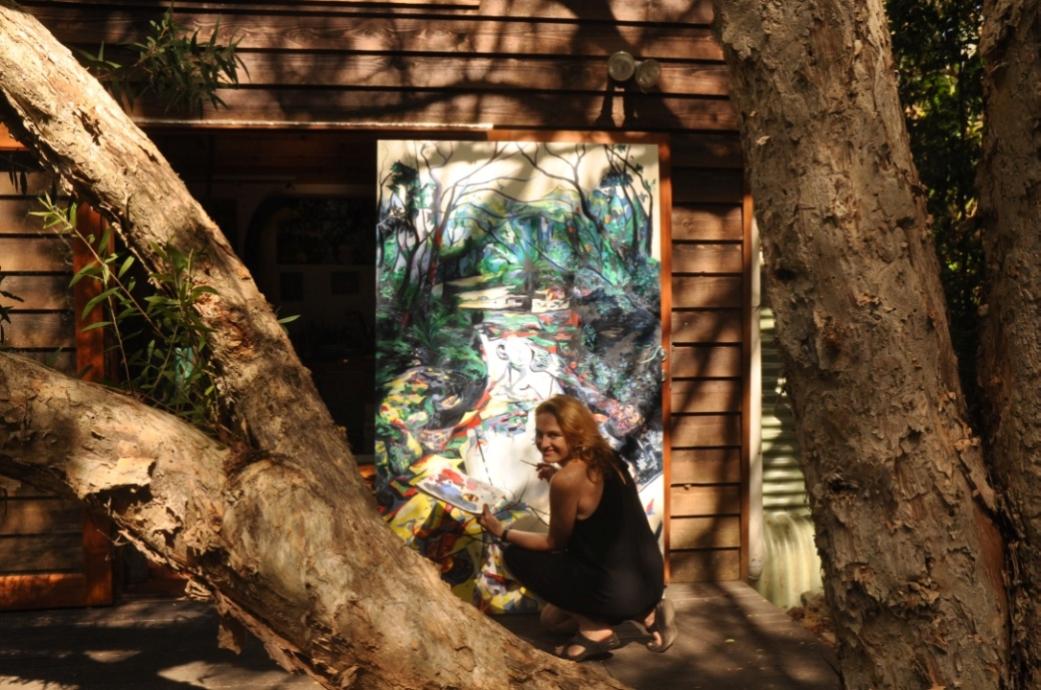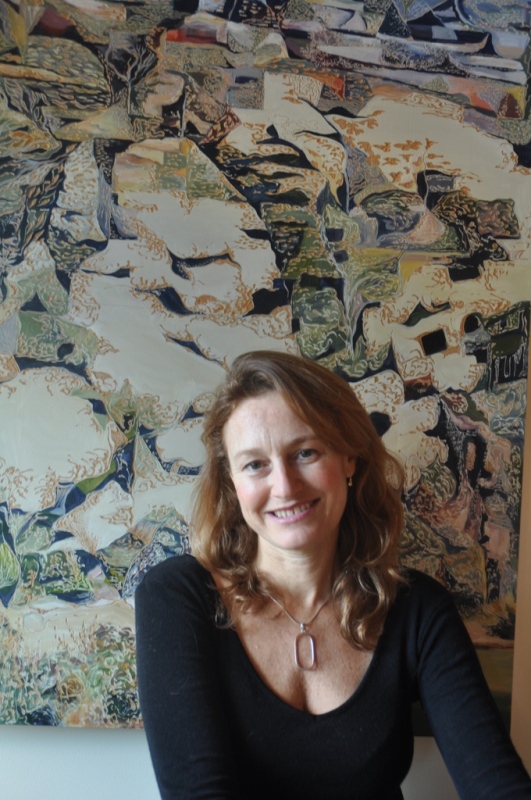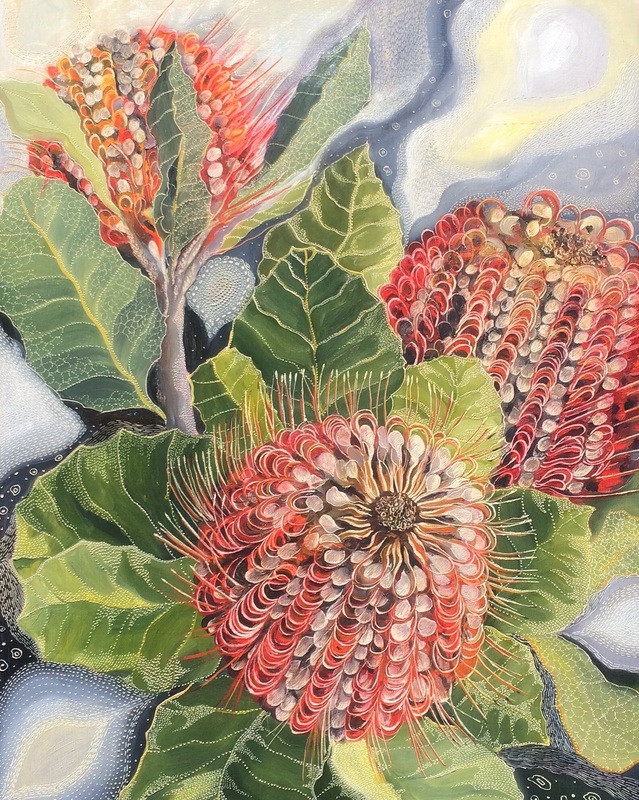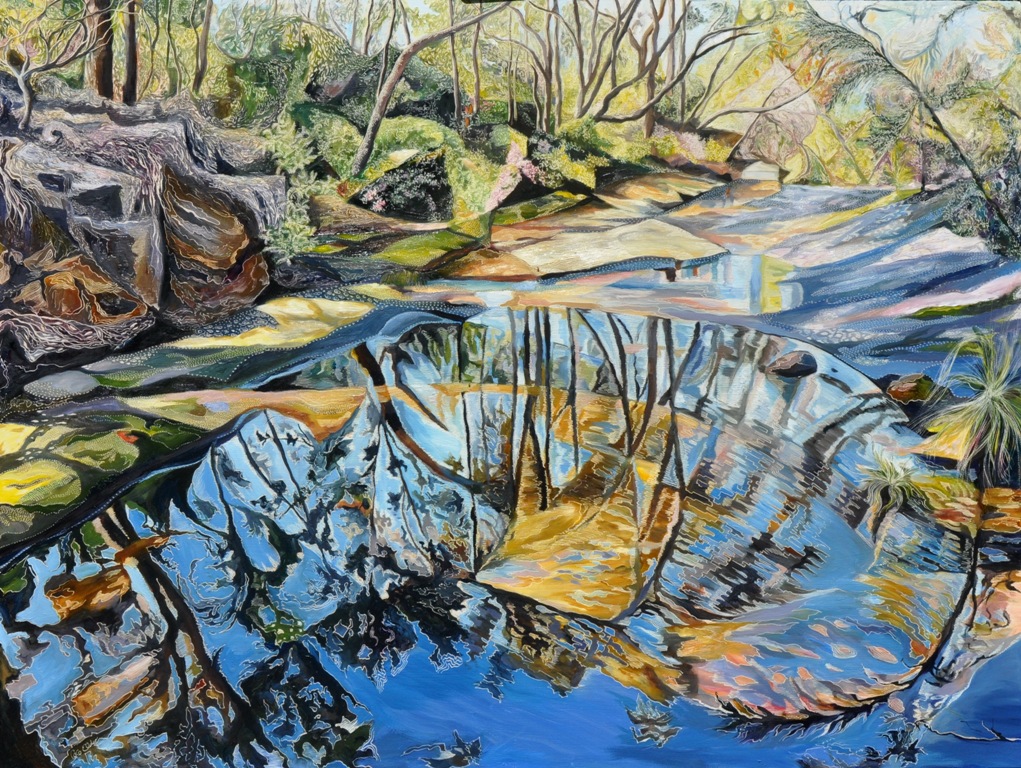March 4 - 10, 2018: Issue 350
Coco Elder

One of our premier Pittwater artists, who finishes her last Pittwater Artists Trail Open weekend for the time being with the March 10-11 event for the trail is Coco Elder, a creator of luminous works that capture the colour, essence and shape of our landscape.
To have just one of these works should be the aim of everyone who lives here - there is something inherently sacred in this ladies' works that communicates the fundamental beauty of the area we're living in and allows you to have something at once filled with blazing light and also a sense of peace. These are celebrations that focus on the miniature as well as the larger scope of big open skies meeting glorious bush.
How did she get to be so good at making these works? This week a small insight into one of our premier local Artists who also features as the March 2018 Artist of the Month:
When and where were you born?
1968- Sydney
 Where did you grow up and what did you do for play as a child?
Where did you grow up and what did you do for play as a child?I grew up in the Eastern suburbs in an unusual Paddington Terrace, just around the corner from Margaret Olley.
It was unusual as it was not flanked either side by another terrace on one side it had a garage and behind that was our magical garden with a huge liquid amber tree.
On the weekends we would drive to Medlow Bath in the Blue Mountains where we stayed in the shack, that Mum and Dad renovated over the years. It was here that I found clay at the side of the road. I learnt to make little pots that we’d fire in the open fireplace; catch tadpoles in the back creek and bring them back to Sydney to watch them turn into frogs. I’d play with my brother and sister in the garden and loved making miniature gardens. These experiences fuelled my love for nature.
Where did you go to school?
I went to the local public primary school in Paddington, followed by SCEGGS Darlinghurst. Initially I studied Landscape Architecture but found that after second year, there was less scope for making artworks with Graphics and Design and greater focus on Engineering & Computing.
I was always going home to draw and tended to leave my assignments to the last minute as they weren’t inspiring.
A mature aged fellow student asked me a question which triggered much self reflection: What if this was your last day here on this planet; are you really doing what you want to do?
Clearly I wasn’t and I applied for Fine Arts & studied at UNSWCofa.
After completing my BFA majoring in Painting & minoring in Ceramics, I had exhibitions with local Artists in Newport, with whom I had formed an Artist’s group: Art of the Ordinary.
Our group exhibitions at the Robin Gale Clubrooms- Newport Surf Club were very successful and brought further commissions and public interest.
However, in 1997 I lost my studio and entire house through a falling grey gum in a wild storm. The whole house had to be demolished along with my studio which incited me to go back to study and in 1999 I completed a Bachelor of Art Education at UNSWCofa.
My son was born in 2000 and I did not want to give up my art practice. It was from this point on that I gradually learnt to combine the discipline of teaching Art alongside my art practice. Just as I hope to inspire my students, they inspire my practice as I shift between a very lively, dynamic classroom to the solitary, peaceful space of my garden studio.
Lecturing at COFA – what was your subject?
I was invited back to UNSWCofa to teach: Making Curriculum in Visual Arts & Design where I taught first year Art and design students studying Education how to write Curriculum.
What was the first thing you created?
Probably the first thing I ever made would have been a drawing. Unfortunately I don’t have my very first artworks but I do have drawings of houses surrounded by rambling gardens, going back to about the age of 8. My parents still have my very first oil painting of a blue bottle, which they wouldn’t let me throw out.
Have you always been creating?
Yes, I have always been creating. Having a father as a painter meant that I always had art equipment around the house. The wonderful smell of oil paints, linseed oil and turps that used seep out from the attic where he used to paint inspired me to hang out with my Dad and make art works alongside him.
My mother was also very encouraging and as parents, they both used to sketch us as children and take us to art galleries particularly around Paddington but also the AGNSW and the National Art Gallery. My greatest early visual impact was seeing Arthur Boyd’s forest of gum trees from the Shoalhaven series, exhibited at my favourite gallery, which no longer exists; The Holdsworth Gallery in Holdsworth Street, Paddington.
How did this develop into your current practice?
As a child, creating artworks always gave me a sense of inner joy. Taking Visual Arts as an elective at high school enabled me to find my haven. I had a great connection to my Art teacher who introduced me to a group of artists from the Nabi, specifically Vuillard & Bonnard. These artists and Olley were my early influence on interior drawings and still life. I loved their use of colour and light. Having my artwork selected for an exhibition in Nagoya, Japan, as a young teenager, and then winning the Art Prize in my final year of High School gave me great encouragement.
Initially, I thought to study Architecture but being 2 marks off, I pursued my second choice, Landscape Architecture. Although this degree did not give me a sense of fulfillment, it gave me the foundations of understanding the land through geology, botany and field studies that later fuelled my interest in painting landscapes. Moving to the Northern Beaches expanded my interest to explore this genre with a love of the bush and the discovery of Ku-Ring-Gai Chase not far from my home.
What makes for a successful Artist?
A sense of playful imagination, commitment and truth. Being true to who you are and having the determination to express one’s truth in unique and imaginative ways.
Do you also offer classes/teach outside of your career as an art Teacher?
Perhaps one day but teaching Years 7-12 at high school and yoga classes alongside my art practice keeps me very busy.
Who have been your major influences on your work and its development?
Certainly my Dad was a huge influence. Initially his palette knife Expressionist style with Impressionist use of colour and light was of great influence. His artwork has changed over the decades and his resilience in being so versatile with his styles ranging from abstract expressionism to incorporating sculpture in his paintings made him quite unique.
I was particularly influenced by his carving into painted timber screens using a drill and chain-saw. I loved the layered effect that this achieved. This inspired my carving into paint using an engraving tool.
I also discovered the beautiful work of Joshua Yeldham who also carves and sources imagery from Ku-ring-gai. Fred Williams’ simplification of the land and Cezanne’s understanding of the geometry of the land have also been highly influential with my work. I also have great admiration for the simplicity of Japanese scrolls and their reverence for nature.
You have an innate sense of the natural world which clearly influences your work – where does this stem from?
As previously mentioned, this comes from spending time in the Blue Mountains as a young child, playing in the garden that expanded to the bush, where I would often get lost exploring. I would feel an element of sadness & confinement coming back to the city. Studying Landscape Architecture helped me develop my understanding of nature and then spending time in nature, exploring places such as Ku-ring-gai enabled me to connect to the spirit of the land. I feel the spiritual presence of our Indigenous people in many areas at our doorstep in Sydney and throughout our country. I feel we could be learning more from our people who know the benefits of treading lightly on this planet and turning to nature for guidance. The natural world gives a space and time to rejuvenate, it fuels my senses.
This is your final Open Weekend on the Pittwater Artists Trail for the present time; what has being on the Trail given you?
The Pittwater Artists’ Trail has given me a wonderful opportunity to connect with some amazingly talented artists and genuinely lovely people aside.
The Open Studios has brought me in touch with audiences not only from the Northern Beaches but further afield who have given substantial support and feedback. The yearly group exhibitions have allowed me to mingle with many fascinating people in the local community and surrounding art world. The Trail functions on the generosity and selfless commitment of each member to offer their services in areas of their strength to help build the group. This is a wonderful form of artistic collaboration.
What are your favourite places in Pittwater and why?
I love the America Bay Track in Ku-ring-gai, particularly in Spring as all of the various grevillea come into flower and the heath becomes a spray of visual delight. The reflections in the creek provide endless visions into other worlds. The Angophoras and Banksias are also sensational on this track but it was following the waratahs off this track that lead me to a secret swim hole that has been a favourite place to paint.

I’m also fond of the escarpment at Illawong Bay and Refuge Bay with it towering rocks and waterfall. Recently, I discovered the hidden beauty of the Warriewood Wetlands with its magical falls, tall closed rainforest and green moss covered boulders. This place is currently under threat to be wiped out and developed by hundreds of housing blocks. This would be devastating.
What is your ‘motto for life’ or a favourite phrase you try to live by?
Be still, be true, follow your heart.
Coco Elder
Carvings Drawings Ceramics
Coco is a practicing artist specialising in Painting and Ceramics. Alongside her teaching position in Visual Arts at a high school on Sydney’s Northern Beaches, Coco has also been a Lecturer at the College of Fine Arts (COFA) at UNSW.
Her greatest inspiration and love of life is the Australian natural landscape. As a child, Coco learnt to shape pots from clay found on the side of the road with weekends spent in the Blue Mountains. Her Father, also a painter, instilled the love of oil paints and dabbling with the elements of texture, colour and movement, along with inspiring aspects of Expressionism, Abstraction and painting with light.
Following the loss of her home and studio with a crashing grey gum in a storm, back in 1997, Coco was driven to complete her Bachelor of Art Education degree. Working between the disciplines of teaching and practicing artist, enables her to see ‘the other’ with fresher eyes and renewed clarity. “My teaching profession and art practice have become cyclical, one discipline feeds the other”.
“Painting brings me into the highest state of consciousness. It is in this moment, I lose myself and enter a state of formlessness. The paradox is, that my practice is about creating forms and shaping narratives. It is a journey that keeps me continually seeking….”.
Website: www.cocoelder.com.au
Artist's Statement
My artwork is based on observations of the landscape and flora, notably in Ku-Ring-Gai Chase National Park. My initial study in Landscape Architecture has inspired my interest in geology and indigenous botanical landscapes. Overtime, I have witnessed the bush thrive in the wet, fight or recoil in the dry, and brought back to life after the fires. I hope to transcribe reverence for the Australian bush and to reveal the mysterious and alluring qualities of our native plants and the lie of the land.
The natural landscape presents as an intriguing paradox. Up close, the bush is an unruly entanglement of prickly menace; from a distance, are distinct interlocking shapes that can be ordered by the eye into Cezanne's geometry. Patterns that appear on the macro level are reiterated at the micro. Whilst bodies of water lead the eye in and outwards through reflections, there is a mysterious chasm in time, yet it also appears infinite. Shadows of texture hem and define vibrations of light. I endeavour to capture some of these subtle ambiguities in my work.
I retrace the place, coming closer to the essence of form, yet ironically remove it, by carving back through the surface. The image becomes a visual description that blends aspects of botanical documentation (like the early Australian artists); a journey through nature, (influenced by Japanese scrolls); and a personal expression through patterns of whimsy, and reflections on the past inhabitants, the Carigal people, whose presence are keenly felt.
Carvings
Recently Coco has been painting with oil on board and then carving back through the surface using an engraving tool. This allows her to bridge the two practices of drawing and painting. Cezanne’s process of building up forms of colour and simplifying the landscape into geometrical forms inspires the initial process of oil painting on board. Coco breaks down form via areas of shadows and light. The forms then come to life with textural overlays created by the carving process. “ By carving back through the surface, I’m able to create another layer, one that is more playful, and a gestural expression of the form and place”.
Drawings
Coco’s practice has always involved sketching outdoors, particularly in Ku-ring-gai Chase National Park, close to her home on the Northern Beaches where she is surrounded by natural bushland. “I like the immediacy of responding to the landscape in which I find myself. I can sketch the same escarpment over again and new palettes, shapes and forms will present themselves. I may not like what I produce but when I take it back to the studio and out of context, I return to the same moment in time with the realisation I have taken on a small part of that place”. Recently she has been experimenting with carving back through paper.
Ceramics
Working with clay enables Coco to connect with the earth on another level. Recently she has been creating slab vessels that mirror similar shapes of the land and geology. By painting the groggy white clay in a simple black slip, she hopes to reference the recent charred effects from the bushfires. This simplistic black and white colour scheme also references the effects of positive and negative space; shadow and light; and the historical nature of what has past.
Coco is one of the Artists on the upcoming March Open Weekend for the Pittwater Artists Trail;
March 2018 Pittwater Artists Trail
OPEN STUDIO WEEKEND 10 - 11 MARCH
10am - 5pm
Enjoy a creative escape to the beautiful Northern Beaches, visit 17 artists at 10 studios in Terrey Hills, Elanora Heights, Mona Vale, Newport, Avalon and Clareville. Chat with the artists, watch demonstrations, be inspired, find unique gifts for yourself or a friend. We look forward to meeting you.
All studios are open from 10am - 5pm.
About Us
The Pittwater Artists Trail is an alliance of artists who collectively open their studios to the public on two weekends each year creating a Trail for art lovers. Visitors can engage with the artists, see how they work and what inspires them, buy beautiful, original artworks or perhaps enrol in one of the courses offered by a number of artists on the Trail. Map at: www.pittwaterartiststrail.com.au/map
Coco Elder

Submerged Sydney Sandstone. Salvation Creek